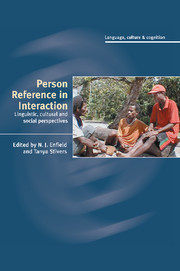Book contents
- Frontmatter
- Contents
- List of contributors
- Preface
- Acknowledgements
- 1 Person reference in interaction
- Part I Person reference as a system
- Part II The person reference system in operation
- 6 Conveying who you are: the presentation of self, strictly speaking
- 7 Person reference in Yucatec Maya conversation
- 8 Principles of person reference in Tzeltal conversation
- 9 The interactional meanings of quasi-pronouns in Korean conversation
- 10 Person reference in Tzotzil gossip: referring dupliciter
- Part III The person reference as a system in trouble
- References
- Index
10 - Person reference in Tzotzil gossip: referring dupliciter
Published online by Cambridge University Press: 22 September 2009
- Frontmatter
- Contents
- List of contributors
- Preface
- Acknowledgements
- 1 Person reference in interaction
- Part I Person reference as a system
- Part II The person reference system in operation
- 6 Conveying who you are: the presentation of self, strictly speaking
- 7 Person reference in Yucatec Maya conversation
- 8 Principles of person reference in Tzeltal conversation
- 9 The interactional meanings of quasi-pronouns in Korean conversation
- 10 Person reference in Tzotzil gossip: referring dupliciter
- Part III The person reference as a system in trouble
- References
- Index
Summary
Gossip in the Who's Who
Zinacantecs gossip continually about the doings of their kinsmen, their neighbours, local officials, ritual officeholders, their friends and their enemies. Among Zinacantecs the great bulk of conversation is just this kind of gossip, targeted at specific people. Stories told ‘on’ a person may be scandalous or innocent, but they are most delectable when interlocutors know who the person is.
Soon after arriving in Chiapas with the help of George Collier I compiled a Who's Who of Zinacantán by recording groups of Zinacantecs as they gossiped about their compatriots (Haviland 1977). We assembled groups of five to eight Zinacantec men from various hamlets around the township. Each group would march mentally down the paths of one village at a time, conjuring up images of each house and its inhabitants, and trying to think of anything interesting to say about people encountered along the way.
I revisit these Who's Who conversations and some of their sequels to consider the shared theme of this volume: linguistic and cultural resources, competing social motivations, and interactive prerequisites for ‘referring to persons’. Several ethnographic themes – ‘triangular’ kinship, social geography, the semantics of names, and the nature of biographical representations, among others – arise in considering Zinacantec ways of referring to one another. I will argue for the essential multiplex nature of person reference, which in collaborative interaction always involves the indexicalities of stance.
- Type
- Chapter
- Information
- Person Reference in InteractionLinguistic, Cultural and Social Perspectives, pp. 226 - 252Publisher: Cambridge University PressPrint publication year: 2007
- 5
- Cited by



